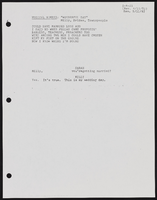Search the Special Collections and Archives Portal
Search Results
Danit Farwell oral history interview
Identifier
Abstract
Oral history interview with Danit Farwell conducted by Barbara Tabach on March 27, 2018 for the Southern Nevada Jewish Heritage Project. In this interview, Farwell discusses her early life in Morocco, antisemitism she experienced there, and being sent to Israel as a young girl. She recalls the hardships she faced while traveling to Israel, living in a kibbutz, and completing a teaching seminar to become a grade school teacher. Farwell talks about arriving to Las Vegas, Nevada in 1974, her first impression of the city, and her decision to stay. Farwell describes becoming a member of Temple Beth Sholom, being a teacher there, and going to card dealing school. Lastly, Farwell talks about being a part-time card dealer at different casinos on the Strip.
Archival Collection
Jane McCarthy oral history interview
Identifier
Abstract
Oral history interview with Jane McCarthy conducted by Claytee D. White on November 06, 2006 for the UNLV @ 50 Oral History Project. In this interview, McCarthy discusses her involvement with the University of Nevada, Las Vegas (UNLV) College of Education and their outreach program with the Navajo Nation. She explains that UNLV professors visit the reservation and offer graduate classes to teachers. McCarthy describes the reservation she visited, doing her sabbatical on the reservation in 2002, and the challenges that come with teaching Navajo children. Later, McCarthy recalls how she became involved with the Accelerated Schools Project, starting her career at Stanford University, and the differences between Stanford and UNLV. Lastly, McCarthy talks about the No Child Left Behind Act and the shortage of teachers in the Clark County School District (CCSD).
Archival Collection
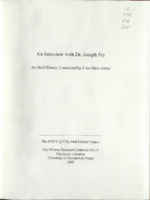
Transcript of interview with Dr. Joseph Fry by Lisa Gioia-Acres, October 09, 2007
Date
Archival Collection
Description
Text
Mildred Mann Papers
Identifier
Abstract
The Mildred Mann Papers (1915-1995) contain documents related to her involvement in teaching ceramics and her work with the Independent Order of Odd Fellows. Included are correspondence, newspaper clippings, magazines, certificates, childhood school materials, manuals, photographs, a scrapbook, and newsletters. There are also Clark County Community College (CCCC) class schedules, real estate papers, and membership lists.
Archival Collection
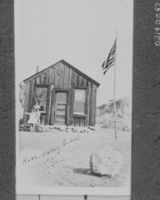
Photograph of Rose Valley School, Rose Valley, Nevada, 1931
Date
Archival Collection
Description
Image
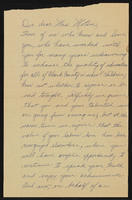
Mabel Hoggard: educational correspondence
Date
Archival Collection
Description
Folder of materials from the Mabel Hoggard Papers (MS-00565) -- Educational work and legacy file. This folder contains correspondence to and from Mabel Hoggard related to her teaching career. Correspondents include the University of Nevada, Las Vegas; Oran K. Gragson; Attorney Harry H. Jones, OCD supervisor; Mabel Hoggard Elementary School; Clark County School District; Department of Education, and others.
Text
Dr. James LaBuda oral history interview
Identifier
Abstract
Oral history interview with Dr. James LaBuda conducted by Rhonda Calvo on November 08, 2004 for the Public School Principalship Oral History Project. In this interview, LaBuda reflects upon his more than 20-year career as an elementary and junior high school teacher and administrator with the Clark County School District (CCSD) from the 1980s to the 2000s. He describes the process by which he became a teacher, and eventually a principal, as well as some of the challenges that he faced at different schools. He discusses challenges surrounding cultural diversity, standardized testing, and the 1988 PEPCON explosion. He reflects upon his training that he believes was the most beneficial for his principalship, discusses his approach to educational leadership, and describes expectations that successful principals would commonly face.
Archival Collection
Mary C. Hurtado oral history interview
Identifier
Abstract
Oral history interview with Mary C. Hurtado conducted by Angie DeLong and Sophie Romani on May 27, 2008 for the History of Blue Diamond Village in Nevada Oral History Project. Hurtado opens her interview by recalling her third grade year at the Arden School in Blue Diamond, Nevada. Hurtado describes her favorite teacher, Ruby Danny. She then describes other teachers at the school, her childhood in the 1920s in Blue Diamond, and community events such as gift giving during the Christmas season. She discusses how it was necessary for residents of Blue Diamond to visit Las Vegas, Nevada for supplies and healthcare. The interviewers and Hurtado then describe their favorite Blue Diamond residents. Lastly, Hurtado talks about the importance that all family members pitch in to survive in a rural area like Blue Diamond during the 1930s.
Archival Collection
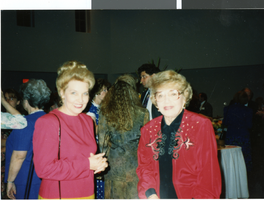
Photograph of Darlene Unrue and Edythe Katz at a University Library Society reception, Las Vegas, Nevada, circa 1991-1992
Date
Archival Collection
Description
Image

